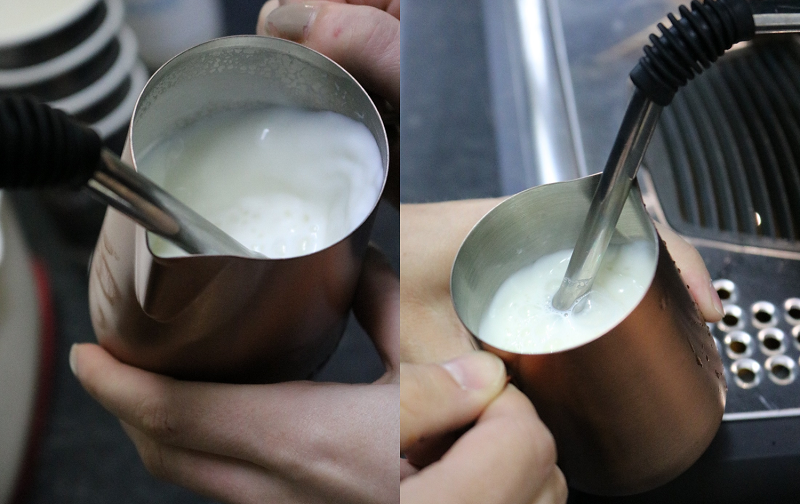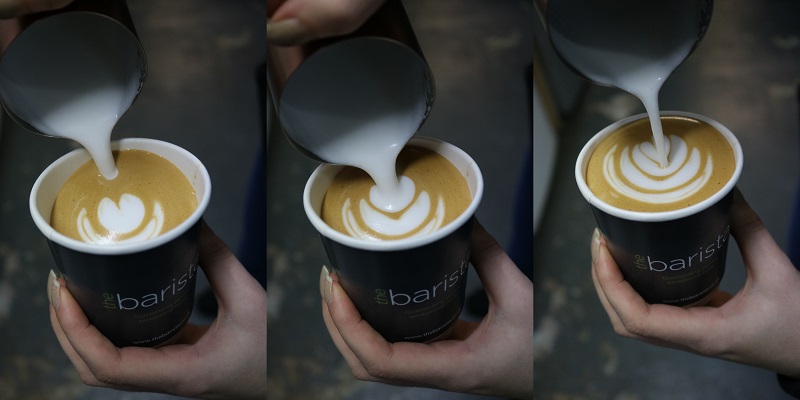The base of any great coffee starts with freshly ground beans. Coffee tastes best a week or so after roasting as it will have had the time to de-gas. One of the best ways of getting the most out of coffee is to grind it as required (and not in advance) to ensure the coffee is preserved as long as possible. For this reason, we grind fresh beans to order throughout our mobile coffee services.
To make a latte, you first need to prepare an espresso as the base. For this, we use freshly ground beans that are fine in consistency. Grinding the coffee fine for our espresso will slow down the water flowing through the coffee so all of the fantastic flavours are extracted, giving you a richer, fuller flavour in the cup.

1. Preparing the espresso
The first step is to load up the porter filter with freshly ground coffee. A couple of gentle taps on a hard surface levels out the grounds to ensure its evenly filled, then the coffee is compressed down into the basket using the tamper.
We grip the tamper firmly and press down using our body weight to create a nice flat surface. This process compresses the grounds together tightly, which will reduce the speed of the hot water as it flows through for a deeper flavour. It’s key here to create a flat surface as this will allow the water to pass through the coffee grounds evenly.
Finally, it’s time to add the water. We run a little water through the group head first to ensure the flow is fresh, then attach the porter filter. A good espresso is made up of around 30-40ml of liquid which should take around 30 seconds.

2. Foaming the milk
The milk is the stumbling block for most lattes. Over heated or burnt milk ends up as solid-ish foam with a faintly bitter taste. The perfect latte milk wants to be viscous, smooth and creamy, with a neat layer of foam at the top.
It’s important to give the steam wand a couple of blasts to get rid of any residual liquid in the nozzle. Then we place the steam wand into the jug of milk at an angle, so the nozzle end is just under the surface of the milk. It’s slowly turned on and the milk is gently rotated, swilling the milk round as it heats. A hand placed at the base of the jug helps us to monitor the temperature.

4. Now for the pouring – and tasting!
Once the milk is foamed to perfection, we pour it over the espresso at an angle, maintaining a steady speed. Initially, we pour the milk from slightly higher than the top of the cup and slowly bring the jug down to the edge of the cup as we start our latte art pattern of choice – the sign of a master latte.
Then it’s over to you for the tasting!
We set our mobile coffee machines 96 degrees so that we extract the very best from the coffee. This also means that our coffees are drinkable almost immediately. All that’s left to do is hand the customer their latte and wave them on their way!
We’ve spent a lot of time at The Barista perfecting our standards, be this the roasting or the serving, and it’s one of the things we’re most proud of. A coffee stand may only be one small element of our clients’ event, but it’s important to us that it’s spot on.
Our team of baristas are professionally trained and know how to make an extraordinary coffee while providing a warm and friendly welcome. Take a look at our meet the team page to get to know some of the faces behind the delicious beverages!
Want to learn more about our coffee? Visit our coffee page or get in touch to find out more about what we do.
